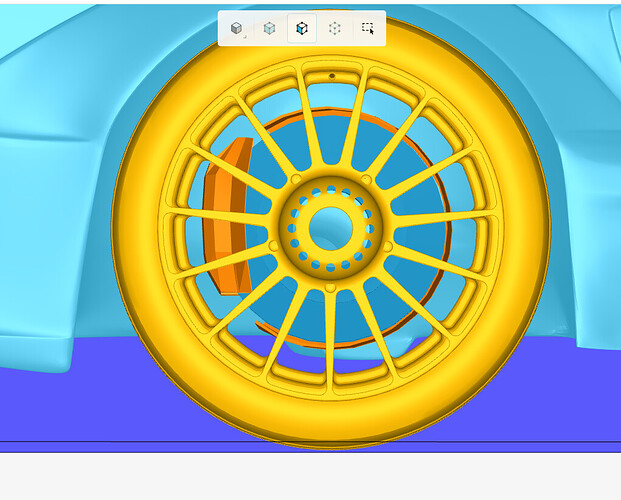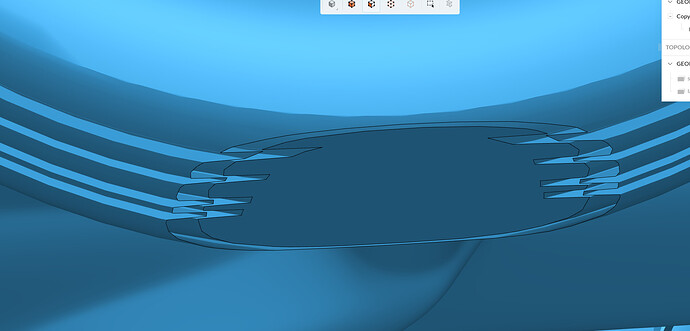Hi,
I have done a few simulations in simscale, so i guess i set it up right. There´s an intersection of my car body with itself, but i dont know where. If i check the coordinates out of the mesh log, its just a point in the middle of my enclosure, no object close to that point…
maybe you can help me out here, its for my bachelor thesis, Thanks!
Hello and welcome to SimScale!
I took a look at your model geometry. It looks like you have a plane that is placed just above the bottom of the tires, which typically denotes the ground plane to use in your analysis:
I would recommend setting your external flow domain box equal to (or slightly higher than) this plane and re-running the operation.
Furthermore, you may then run into issues with the mesh where the ground plane and the tires meet at a tangent. This is commonly alleviated by adding a small platform below the contact patch as described in this thread.
Let me know if those recommendations resolve your meshing error.
1 Like
Oh, Thanks for the advise, really appreciate it. I totally forgot to delete that face, I just hided it, but it made no problems after importing… but anyways, I will try out! do you know if the simulation still works properly with the rotating wheels, even if I cut the wheels? Last time I cut the wheels, it looked a bit awkward, like a hole in the flow region…
I could just check this problem by simulating the wheels separately quick, but I don’t want to waste one of my simulations as a student…
Thanks!
No problem. You will have a “hole” in the bottom of the flow domain where the tire/contact patch extension meets the ground. This is totally ok. It is common to include the small extension from the contact patch in the rotating velocity (wheel) BC. The key is avoiding any intersecting faces at the contact patch in order to mesh successfully and with a high degree of quality. Good luck!
okay… i need to get back to you… I´v already tried everything i know… The mesh just doesnt want to work well. I got one mesh, where the faces on the car were way too course and too big, so there would be no development possible. So i tried different settings, different refinement sizes, different sizes for the flow region… and also different solver for the mesh, so standard, hex , and so on. Sometimes it fails due to intersecting errors, sometimes it failes because the system runs out of memory… i`m really in trouble rn.
and yes i deleted that plane, i forgot to delete in the first run…
i also have to add that i wasnt able to set to flow region for only the half of the car ( idk why, but i didnt want to work), so i decided to keep both sides for the sim. Also because the exhaust system is only on the left side of the car. But if you know why my car body wasnt able to be splitted by the flow region, i might try again and the half mesh side would probably work in a better way
I will take a look at your case linked above (I assume that is the latest and greatest project).
In general, if you set the mesh level too fine the case will run out of resources (memory). This is especially true on the community level account where you have access to only 16 CPU cores and less RAM.
I’ll let you know what I learn after looking over your project.
1 Like
thanks that you are having an eye on me! its the same, yes. Latest CAD. meanwhile “6” meshes…
Just at first glance, I see that you did not create the small extensions/platforms where the tire meets the road. This will be critical to avoid coincident faces and very poor mesh quality at these locations, and even more essential considering you have the circumferential treads on the tires:
The standard mesher will be even more sensitive to this, as it is built from the surface mesh inward.
Outside of this, your “Region refinement 2” is set to 10 mm and is quite a large volume (your small Box). This will drive up the meshing far beyond what can be run on the community platform. I would recommend shrinking this box down closer to the vehicle and setting the size to 20-25 mm. The large box could be shrunk down a bit and used as an intermediate mesh of ~50 mm if you have any overhead left.
Give these two modifications a try and let me know the results.
i know, i just havent done in the past, so i thought it wouldnt be the reason of my problems… anyway. I tried the different settings you recommend. no success… do you think a construction of those plates on the ground will solve the problem?
i also asked the service for a student subscription for more power… maybe this will help
Actually I am close to despair right now. Again i tried different settings. different mesher. different cad simplifications and variations. Sometimes there are errors, sometimes the system runs out of memory. I guess, all the time my case is set up properly, the system runs out of memory, so i never know if my mesh should work. Is there any possibilitx to use my own computer as power unit for the mesh? Its pretty potential, so maybe thats a solution.
Again… i tried a large area of refinement settings, flow area sizes, but nothing works.
i also wrapped the wheels, because they are very detailed and i had a proper simulation run with wrapped wheels, but no success… i`m working on this problem like 30 hours not finding a solution…
the problem is i want to optimize different car parts for real usecase, like front and rear diffusor, spoiler and so on… so a kind of detail in the mesh is necessary… this would be my baseline setup…
its a project for my bachelor thesis, which includes multiple cfd, where proper results are needed… time is running and my mind is running out of ideas… I´m also considering if it will help to mesh with extern programs like snappy hex mesher, but i dont have any experience with that…
Hi!
Some thoughts after having a peek at the latest runs attempts:
- Wrapping is probably not a good idea here, since your CAD is higher resolution than the result of the wrapping operation
- The meshing tool that you are using already is Snappy.
- I echo Nolan’s point with respect to the platforms on the base of the tire. I’d go even further and suggest removing the threads and spokes for the first runs, as you get more used to the process (like what was done in this tutorial)
- Using symmetry for the first passes is also probably a good idea (again, like in the tutorial)
- For the purposes of a bachelor thesis, you are likely going to want more control over the mesh, so I’d say that hex parametric is more fitting. Do go through existing resources such as this and this threads.
Cheers
Hi @RicardoParis, first of all thanks for your effort!
well finally i got a run working with that hex parametric ! It seems pretty fine, maybe you want to have a look at it and tell me your opinion.
After i received access to more core power, i will retry the case with a finer mesh and a larger flow region, but for now i`m happy. I also want to delete the wrapped wheels. I should also consider to simplify the cad of the wheels.
i will also check the mesh tutorials you recommend, thanks for that.
I´m also wondering a bit about my drag coefficient, which is about 0.5. Its not that important, because i dont need absolute numbers, but deltas instead. But i think its quite high, the car should have around 0.36.
new link btw: https://www.simscale.com/workbench/?pid=8789063682296756509&rru=82d4a7e4-664f-4257-964d-85934410c1b0&ci=5e0ed87f-326f-44e2-a981-03b9b49b98d5&mt=SIMULATION_RESULT&ct=SOLUTION_FIELD

